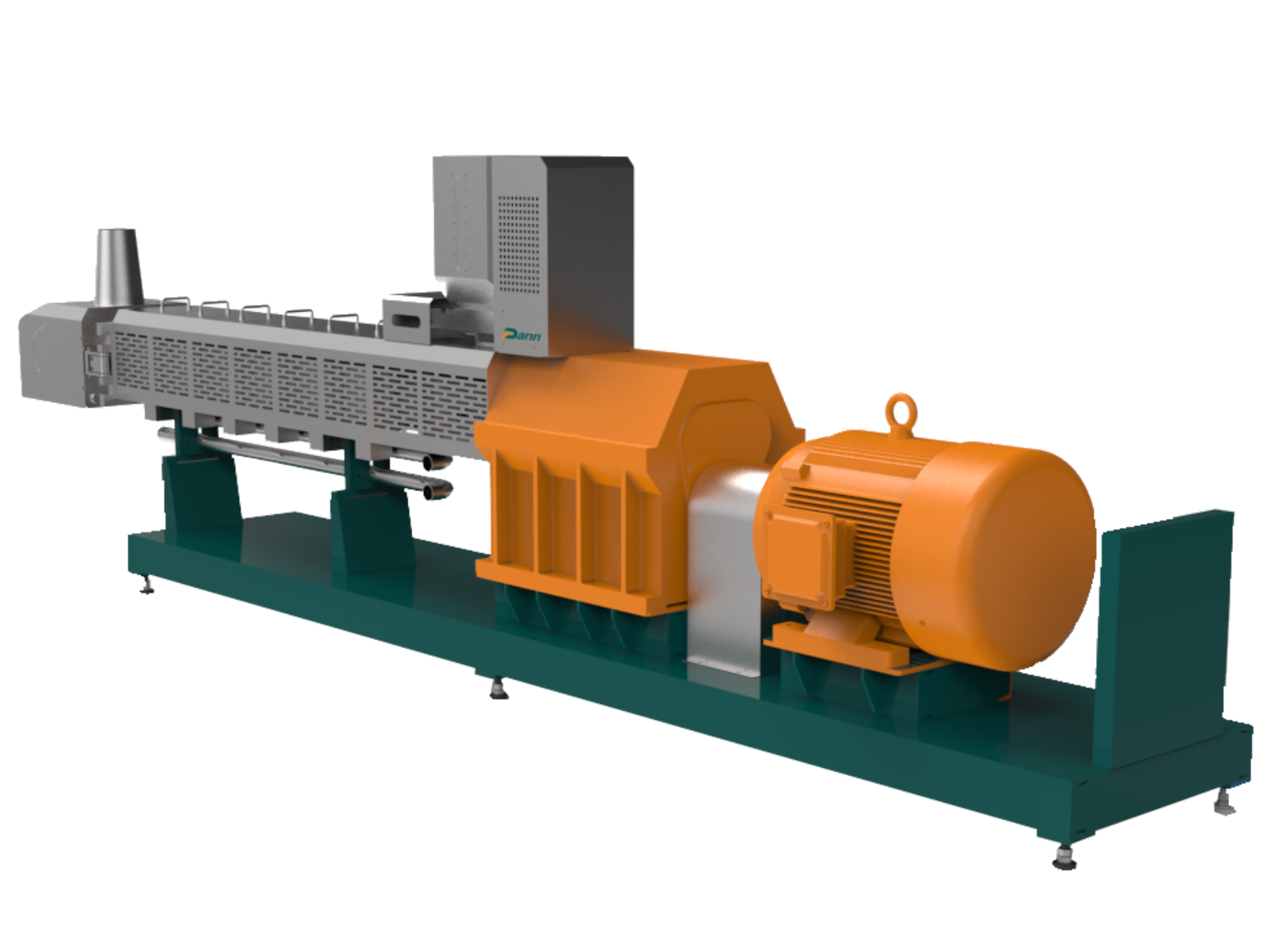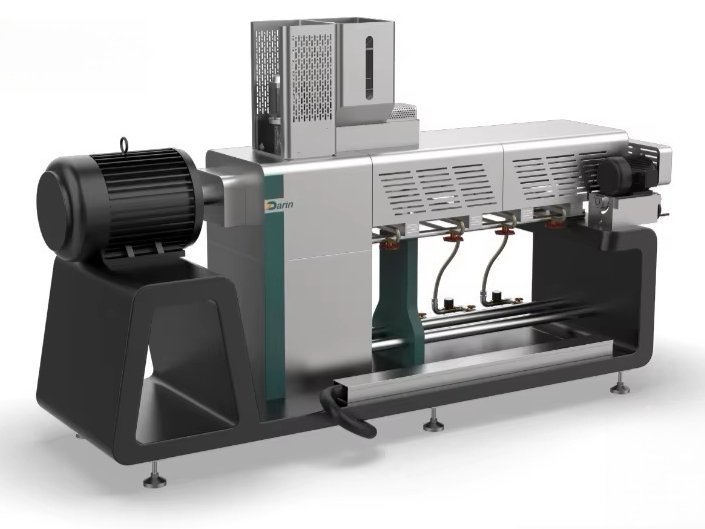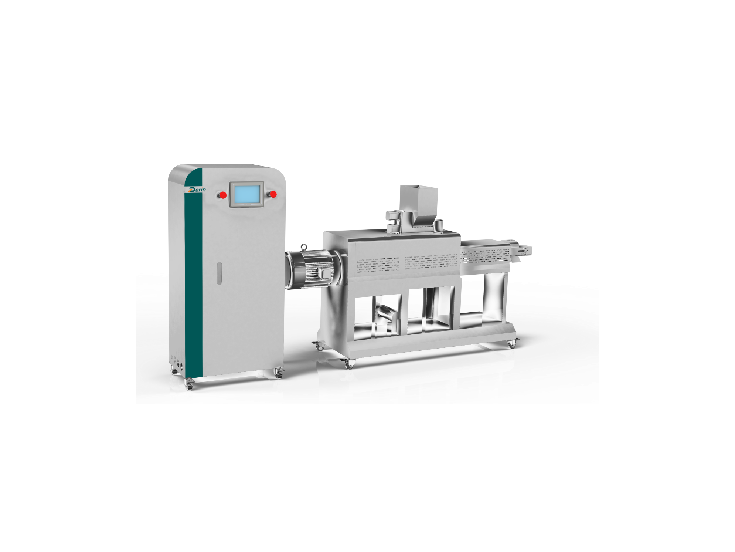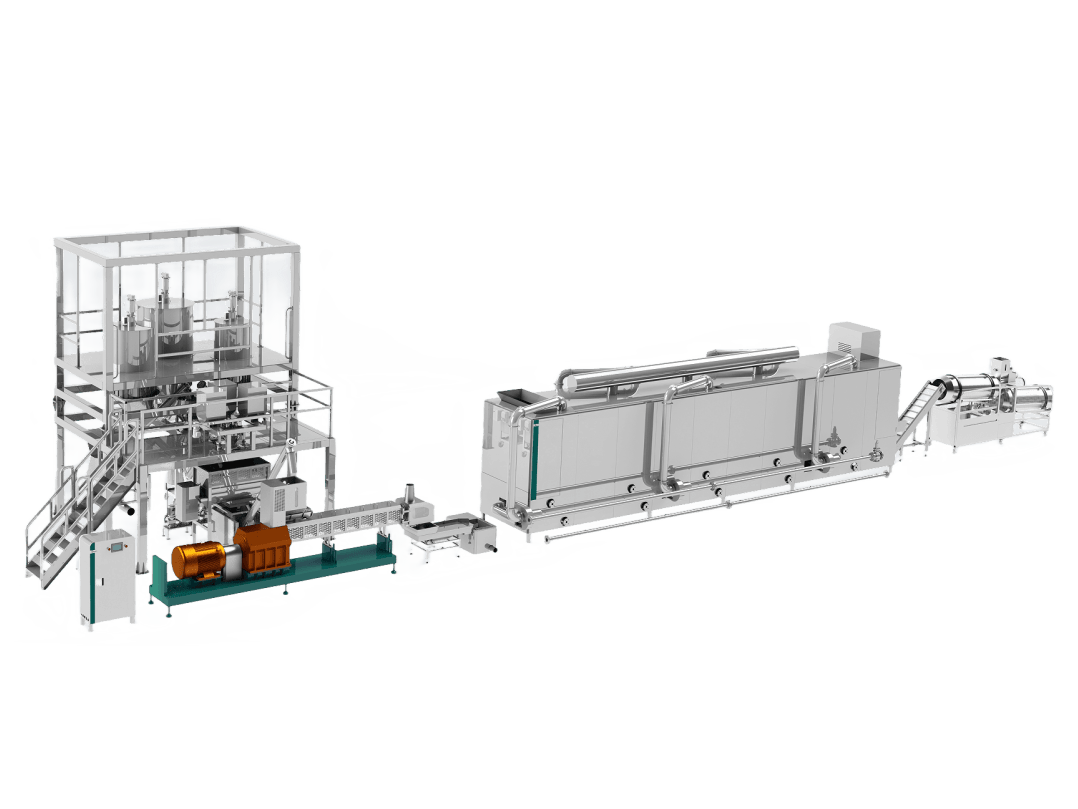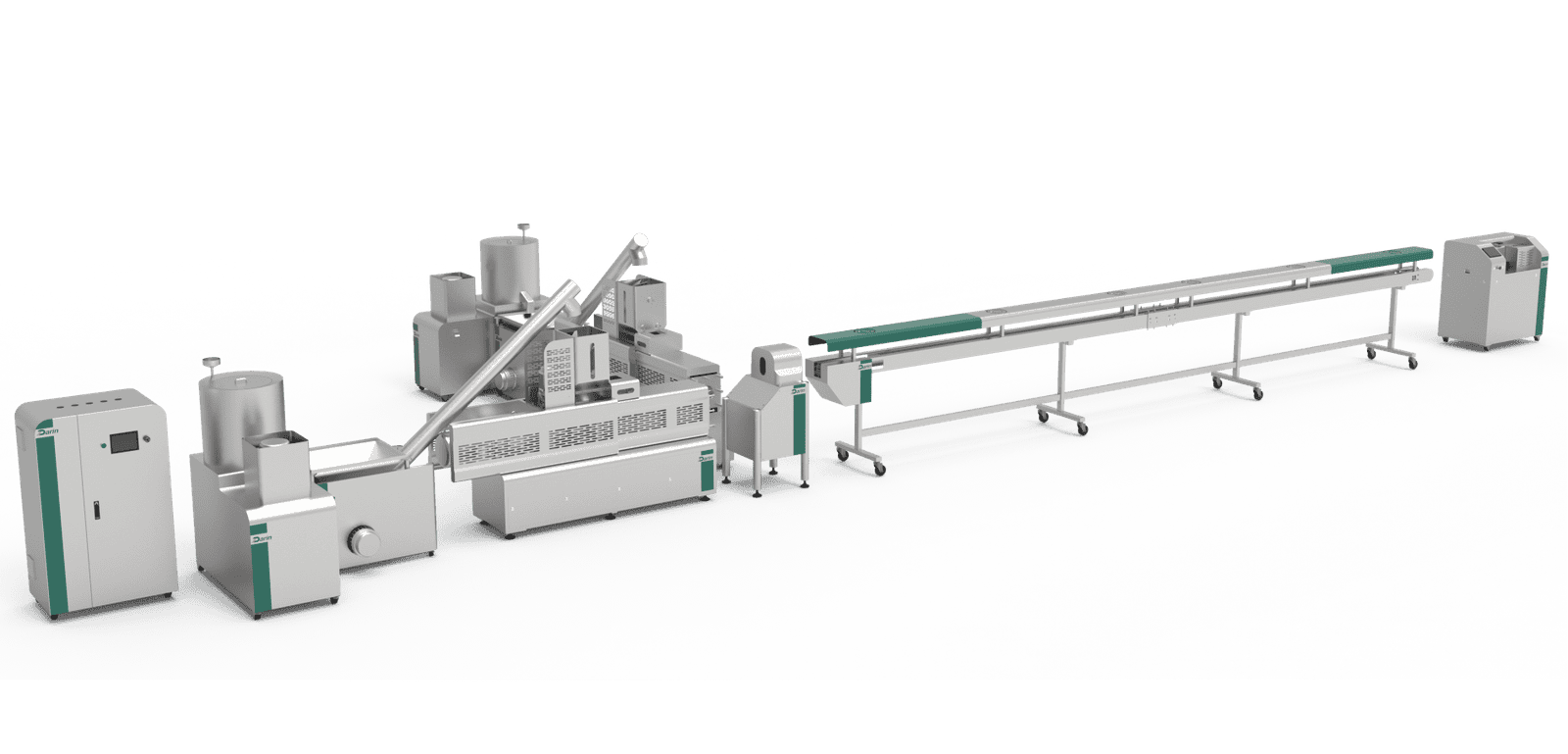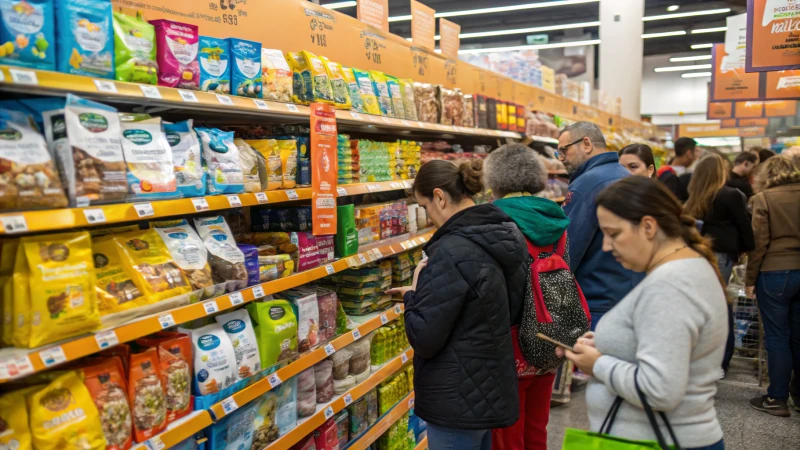
Pet food has quietly become one of the most resilient, profitable, and innovation-rich consumer sectors. The pain point for manufacturers and brand owners in 2025 is twofold: demand is fragmenting (cats rising faster than dogs, premiumization and “human-grade” pushing up formulation complexity), while channels are mutating (e-commerce, interest-commerce, vet-led ecosystems), and costs remain volatile. The consequence of “business as usual” is margin squeeze, missed category waves (e.g., fresh or function-forward), and stalled internationalization. The solution is to re-platform strategy around the four secular drivers (cat economy, online, premiumization, humanization), build a modular brand+product matrix that can pivot across price bands and functions, and harden the supply stack—especially extrusion, drying, coating, and cold-chain where applicable—to ship faster, safer, and at target cost. This article distills the numbers and converts them into a manufacturer’s playbook.
In short: the global cat & dog food market reached USD 147.3B in 2024 with a 2024–2029E CAGR of ~5.7%, outgrowing GDP; industry structure remains tight (company CR3 ~46.7%), profitability is superior to many CPG peers, and leadership is defined by matrix ecosystems (Mars, Nestlé Purina) and sharp differentiation (Hill’s in prescription, Blue Buffalo in natural, Freshpet in chilled fresh). For Chinese manufacturers and brands, the “golden decade” is opening: win with focused product innovation (general nutrition refreshed + functionals/ Rx where feasible), multi-brand architectures, and channel iteration (shelf e-commerce → interest-commerce → professional/vet).
The rest of this report translates those headline findings into concrete steps you can execute now—down to process choices, QA checkpoints, and line-layout implications—so you can turn macro growth into factory-level margins.
Global dog & cat food sales reached USD 147.3B in 2024 and are projected to grow at a 5.7% CAGR through 2029.True
Figures summarized from Euromonitor-style datasets in the brief; 2029E ~USD 194.2B.
Top three companies account for roughly 46.7% of global pet food, a higher concentration than many CPG categories.True
CR3 comparison versus infant formula and beauty indicates structurally tighter competition.
Prescription diets represent a crown-jewel segment with CR3 ~97% and structurally higher margins.True
Category leadership by Hill’s, Royal Canin, and Purina with elevated price/kg and EBIT contribution.
Fresh/chilled pet food in North America is dominated by a single brand with ~96% share.True
Freshpet’s share in U.S. refrigerated segment illustrates first-mover supply-chain moats.
China’s pet food market still has significant headroom in both usage rate and premium mix.True
Penetration and high-end share trail mature markets; secular upgrading supports long runway.
A manufacturer’s answer to 2025’s question: where is the growth, and how do we capture it?
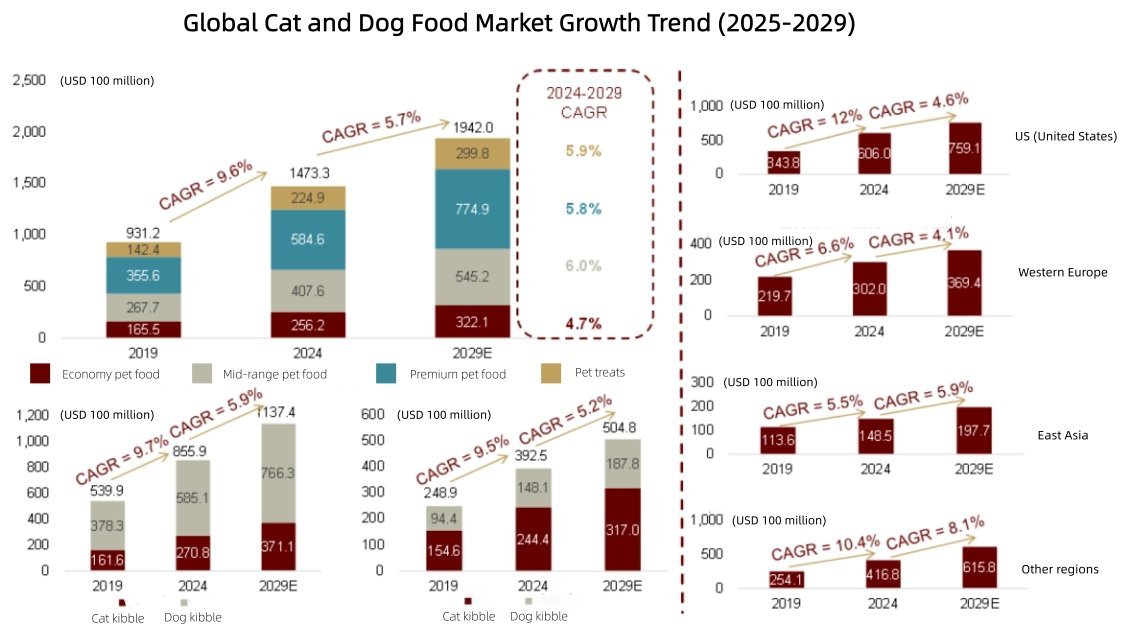
1) The market math you can plan around (size, mix, and where it’s moving)
| Metric | 2019 | 2024 | 2029E | 2019–2024 CAGR | 2024–2029E CAGR | Notes |
|---|---|---|---|---|---|---|
| Global Cat & Dog Food (USD B) | 93.1 | 147.3 | 194.2 | 9.6% | 5.7% | Structural outperformance vs GDP |
| Dry Food | 54.0 | 85.6 | 113.7 | 9.7% | 5.9% | Largest block, cost & texture leadership via extrusion |
| Wet Food | 24.9 | 39.3 | 50.4 | 9.5% | 5.2% | Palatability driver; retort & pouch reliability matter |
| Treats | 14.2 | 22.5 | 30.1 | 9.5% | 5.9% | Dental/functional treats premiumize margins |
| U.S. market (USD B) | — | 60.6 | 75.9 | — | 4.6% | Still the profit engine |
| “Rest of World” ex U.S./W. Europe/East Asia | — | — | 61.6 | — | 8.1% | Next-wave geography for capacity exports |
Manufacturer implications: lock in capacity plans around dry as the anchor (extrusion & post-dry coating), but earmark incremental capex for wet (retort/pouch lines) and functional treats. If you’re pursuing fresh/chilled, plan for refrigerated logistics and in-store equipment (proprietary fridges).
2) Structure and profit: why winners keep winning
| Lens | Pet Food | Infant Formula | Beauty/Personal Care |
|---|---|---|---|
| Company CR3 (2024) | 46.7% | 39.5% | 25.4% |
| Typical EBIT (leaders, multi-year avg) | ~20–23% | ~15–18% | ~15–18% |
| What drives it | Matrix brands + R&D + capex discipline | Regulatory & dairy cycle | Brand equity & channels |
Takeaway: your best defense is a brand matrix + process moat: feed-grade → “human-grade” sourcing control, repeatable extrusion and drying windows, robust QA, and channel-specific SKUs.
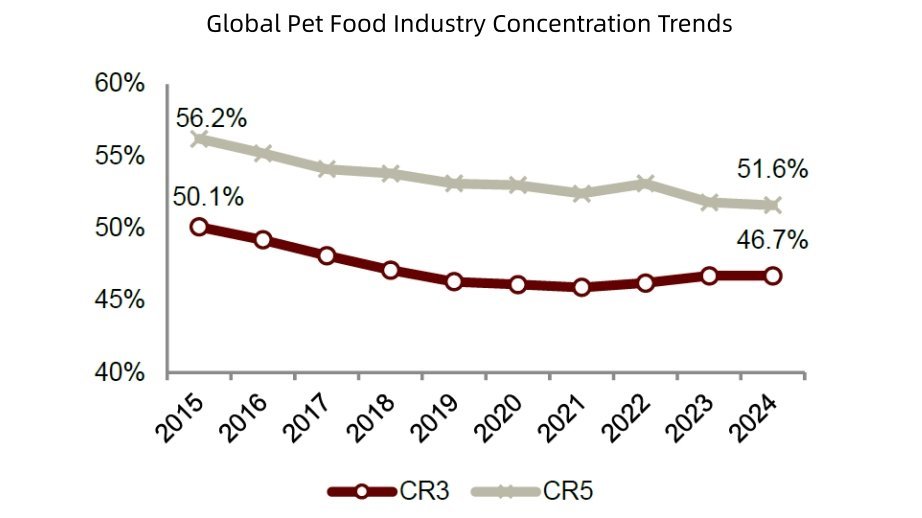
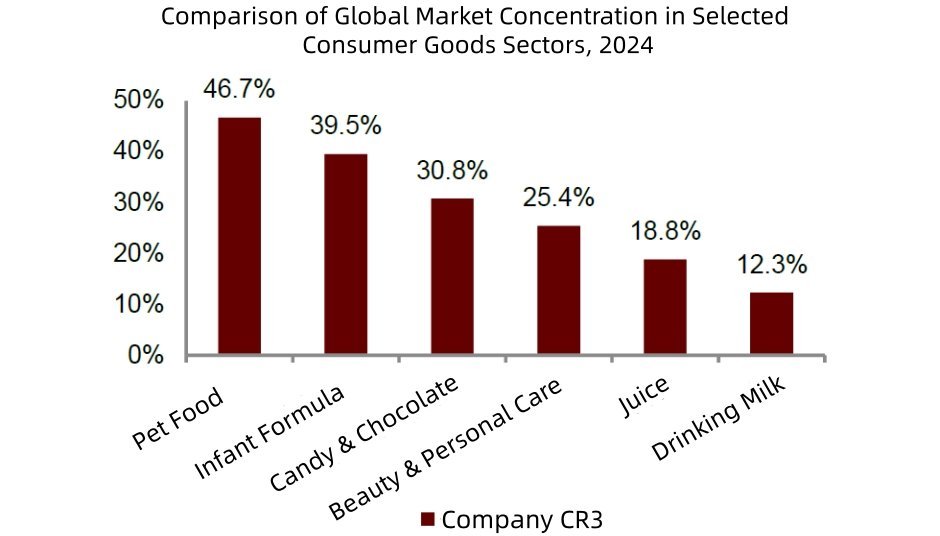
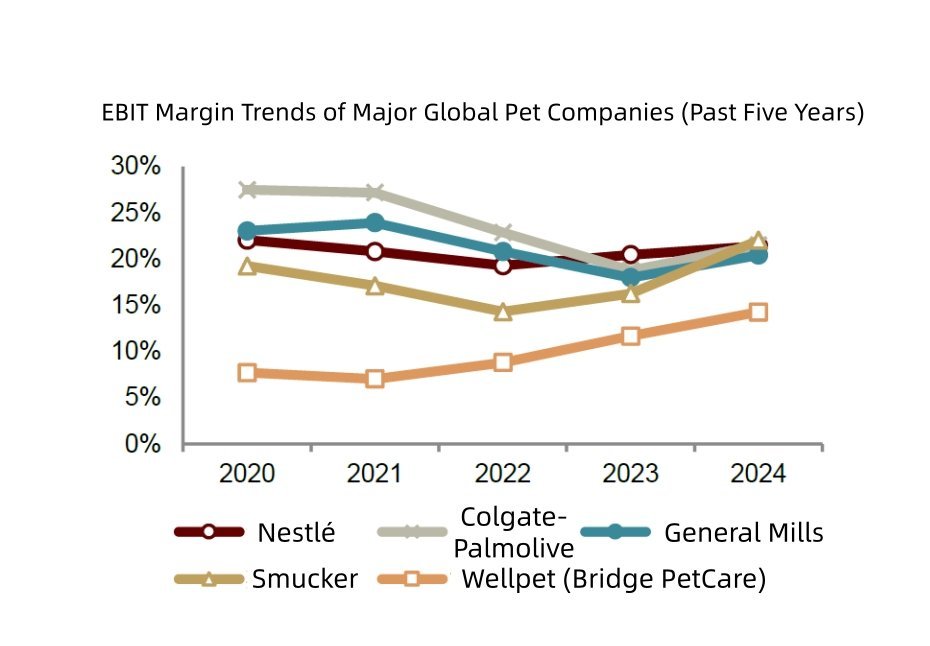
3) Four secular currents you can build lines for
- Cat economy: cats’ share of households and pet numbers has risen globally; cat dry/wet skew requires higher palatability and fine particle control.
- Online & interest-commerce: DTC, marketplaces, and social commerce platforms reward variety and speed; your factory must run shorter changeovers and maintain digital traceability for rapid content-to-shelf cycles.
- Premiumization: higher protein, novel formats (baked, air-dried, cold-pressed), and visible inclusions demand tighter thermal profiles and gentler handling.
- Humanization: “clean label,” transparent sourcing, and prescription/functional benefits (renal, mobility, hypoallergenic) require clinical dossiers, controlled trials, and vet-channel pack formats.
A 10-step technical playbook for manufacturers (Darin Machinery perspective)
Step 1 — Build a modular product architecture that mirrors market tiers
Design a three-tier matrix: Value (mass dry) → Premium (high-meat, natural, visible inclusions) → Specialty (functional/prescription, refrigerated fresh). Each tier maps to specific process windows:
- Value dry: high OEE twin-screw extrusion, 8–12% moisture post-dry, oil/fat coating 6–12%, digest 0.5–2.0%; focus cost/throughput.
- Premium dry: higher FPR (fresh protein ratio), tighter SME control, lower thermal damage; gentle coating for fragile inclusions.
- Specialty: clinical recipes (hydrolyzed proteins, novel carbs), small-batch verifications; for fresh—HPP or HACCP-tight cold chain, ≤4 °C distribution.
Step 2 — Specify the right extruder and die strategy for each recipe family
- Barrel & screw: choose L/D and screw element library to control SME for high-meat doughs (target SME bandwidth ±10%) and support fast changeovers.
- Die & knife: multi-shape die plates with quick-change cassettes; knife hubs that hold cut length tolerance ±0.5 mm for uniform drying.
- Process envelopes: cat kibbles <5 mm with crisp fracture; dog formats 6–14 mm; baked/air-dried lines for premium storytelling when needed.
Step 3 — Drying science that protects palatability and shelf-life
- Multi-zone conveyor dryers with independent T/RH controls; target core moisture 7.0–9.0% (species/format dependent), a_w ≤0.60.
- Edge-to-edge uniformity: ±0.3% moisture at discharge reduces rancidity hotspots.
- Data logging: link temperature, residence time, and belt load to batch IDs for recall-ready traceability.
Step 4 — Coating and palatant engineering for repeatable acceptance
- Vacuum coating for high-fat loads and powder adhesion;
- Inline NIR to confirm surface fat (SFAT) and protein;
- Digest selection: enzymatic hydrolysate for cats; dental or joint actives for treats; adjust application temp (typically 45–55 °C) to protect volatiles.
Step 5 — Wet & pouch lines where growth is fastest
- Retort pouches (foil or high-barrier): formulate with chunk integrity (gelling systems), manage F₀ to safeguard nutrients;
- GR&R on fillers to keep particulates and gravy ratios consistent;
- Post-retort cooling curves to avoid syneresis.
Step 6 — Fresh/chilled if (and only if) you own the cold chain
- Mixing & gentle heat (steam to ≤85 °C), minimal shear;
- HACCP with CCPs on chilling, metal detection, and pack seal integrity;
- Retail fridge programs (lease/maintain) plus route optimization for <4 °C.
Step 7 — Functional and prescription groundwork
- R&D pipeline: hydrolyzed proteins (<10 kDa), renal-friendly phosphorus targets, omega-3 inclusion;
- Clinical substantiation: pilot trials, blinded palatability;
- Regulatory & claims: vet-only SKUs, professional labeling, and restricted promotions.
Step 8 — QA/food safety that earns margin
- Supplier approval (mycotoxin controls for grains; species-verified meats);
- Allergen segregation;
- Kill-step validation and environmental monitoring (Listeria risk for fresh);
- Shelf-life modeling: peroxide value, a_w, sensory drift.
Step 9 — Digital traceability, short runs, fast launches
- MES/SCADA tie-in; QR on packs with batch lineage;
- Changeover SMED: die-knife carts, CIP that hits <60 min between recipes;
- Pilot to scale: 50–200 kg/h pilot extruder mirrors full-scale geometry.
Step 10 — Channel-aware packaging and SKU economics
- E-commerce/interest-commerce: smaller stand-up pouches, higher imageability;
- Vet channel: clinical branding, case-pack logic;
- Mass retail: value packs, pallet patterns for automated DCs;
- Refills & recyclability: LDPE/MDO-PE mono-material where possible.
Two quick reference tables you can take to your next capacity meeting
Table A — Growth segments and their manufacturing levers
| Segment | 2024 Share/Signal | Why It’s Growing | Process Must-Haves | Typical Risks |
|---|---|---|---|---|
| Dry (kibble) | ~58% of value, steady | Cost, convenience, dental textures | High-OEE twin-screw, precise drying, efficient coating | a_w hot spots, fat oxidation |
| Wet (cans/pouches) | ~27%, rising in premium | Palatability, “real meat” cues | Retort control, particulates integrity, gravy rheology | Under/over-processing, syneresis |
| Treats (incl. dental/functional) | ~15%, premiumizing | Humanization, supplementation | Forming variety, low-T drying, actives protection | Label claim substantiation |
| Fresh/chilled | Small but fast niches | Human-grade halo, visible ingredients | Cold-chain mastery, HPP optional | Spoilage, returns, CAPEX in fridges |
| Prescription/functional | High margin, CR3 ~97% | Vet trust, medical need | Hydrolysates, trials, restricted sale | Regulatory limits, R&D intensity |
Table B — Channel shift cheat-sheet (design SKUs to fit the shelf)
| Region | Online Share (trend) | Specialty/Vet Role | Mass Retail Role | Packaging Notes |
|---|---|---|---|---|
| U.S. | Rising to ~37%+ | Vet pivotal for Rx & dental | Still volume anchor | DTC-friendly sizes, case-packs for club |
| W. Europe | ~23%+ | Strong vet ecosystems | Balanced mix | Multi-language, sustainability cues |
| East Asia (CN/JP/KR) | CN/KR very high online | Vet clinics growing | Price-sensitive mass | QR traceability, small pouches |
| Emerging (RoW) | Fast catch-up (from low base) | Limited vet infra | Traditional trade strong | Rugged packs, humid-heat stability |
Brand architecture lessons from leaders (and how to copy the parts that matter)
- Matrix ecosystems win: Mars and Nestlé Purina show how to balance mass brands (Pedigree/Whiskas; Friskies) with premium/specialty (Royal Canin; Pro Plan/Prescription Diets), then bolt on dental, treats, and vet channels.
- Category-creator moats: Blue Buffalo bound itself to “natural,” Freshpet to “fresh refrigerated,” Hill’s to “prescription.” Each moat is half science and half supply chain design (e.g., Freshpet’s fridge fleet).
- For challengers: pick one big idea (e.g., baked, high-fresh-meat, limited-ingredient hypoallergenic) and over-resource that idea before expanding sideways.
China thesis: volume + price mix + channel iteration
- Quantity: cat/dog food usage rates still below mature markets; more households will adopt professional pet food.
- Price mix: high-end penetration has a long runway; unit price/kg can rise with better proteins, fats, and clinically supported functionals.
- Channel: online is already dominant, but interest-commerce is the new acceleration lane; build content-ready SKUs and smaller trial sizes; in parallel, prepare for a vet/professional push (Rx later, functionals now).
What to build next: three line layouts that fit 2025–2029 demand
Layout 1 — Premium Dry + Functional Treats (single hall)
- Core: 3–5 t/h twin-screw extruder, 3-zone dryer, vacuum coater
- Add-ons: small forming line for dental/functional treats; sachet packer
- Output: premium cat/dog dry, small functional treats for online bundles
Layout 2 — Wet Pouch Cell (cat-first)
- Core: kettle + particulates system, piston filler, retort (static/rotary), poucher
- QC: viscosity control, F₀ validation, inline X-ray
- Output: gravy/chunk pouches aligned to rising cat share
Layout 3 — Fresh/Chilled Pilot (beachhead)
- Core: gentle steam cooker, chilled mixers, MAP tray line, blast chiller
- Ops: HACCP lab, micro testing, route planning, branded fridges (if retail)
- Output: city-cluster trial with high repeat potential
KPI dashboard to run weekly (and why it pays)
- OEE by SKU family;
- a_w distribution at discharge;
- Peroxide value drift across shelf-life;
- Palatability two-bowl test deltas;
- Changeover time (die-color-recipe);
- Complaint rate by channel;
- Cost-to-serve by channel (incl. returns/cold chain).
Manufacturers that rigorously run this list typically add 200–400 bps of EBIT within 12 months via yield, rework cuts, and returned-goods reduction.
Risk map (and engineering answers)
- Raw material volatility: qualify dual sources for key meats/grains; implement spec-driven substitutions; hedge where feasible.
- Food safety: invest in environmental monitoring, kill-step validation; for fresh, treat chilling and pack integrity as CCPs.
- Competition: defend with faster launch cycles, channel-specific SKUs, and clinical storytelling where appropriate.
- Regulatory/claims: separate functional from prescription protocols; maintain dossier discipline.
A concise commercialization checklist (print this)
- Confirm target segment (dry/wet/treats/fresh/Rx) and price band.
- Lock nutritional specs and palatability targets by species/age.
- Select process route (extrusion/retort/air-dry/baked) and validate in pilot.
- Build BOM with dual-sourced criticals; define micro specs (a_w, PV, TVN).
- Model COGS @ 80% line utilization and re-quote quarterly.
- Engineer pack sizes for channel and logistics.
- Design changeovers (dies, coatings, pack art) to <60 min.
- Create QA plan (kill-step, allergens, traceability, shelf-life).
- Run palatability and, if functional, clinical/field trials.
- Launch via the channel most favorable to the format; collect cohort data and iterate.
Ending: why this matters now
Pet food’s “triple crown”—big business, good business, evergreen business—is not a slogan; it’s an operations challenge. The brands that will own share in 2025–2029 are the ones whose factories flex across short runs and premium textures without losing a gram of yield or a tenth of a point of a_w control. If you translate the four secular trends into line capabilities, QA routines, and channel-specific SKUs, you’ll convert growth into margins that stick.
Talk to Darin Machinery — Let’s turn your strategy into a production reality
As a manufacturer of extrusion, drying, coating, and complete pet food lines, Darin Machinery can help you design or retrofit lines for premium dry, wet pouches, treats, and fresh—with validation protocols and ramp plans tailored to your channels.
- Website: www.petreatsmachine.com
- WhatsApp: +86 156 5000 7983
- Email: darin4@darin.cn
Tell us your target segment, throughput, and pack formats. We’ll propose a line layout, utility list, and ROI model you can take straight to your board.


